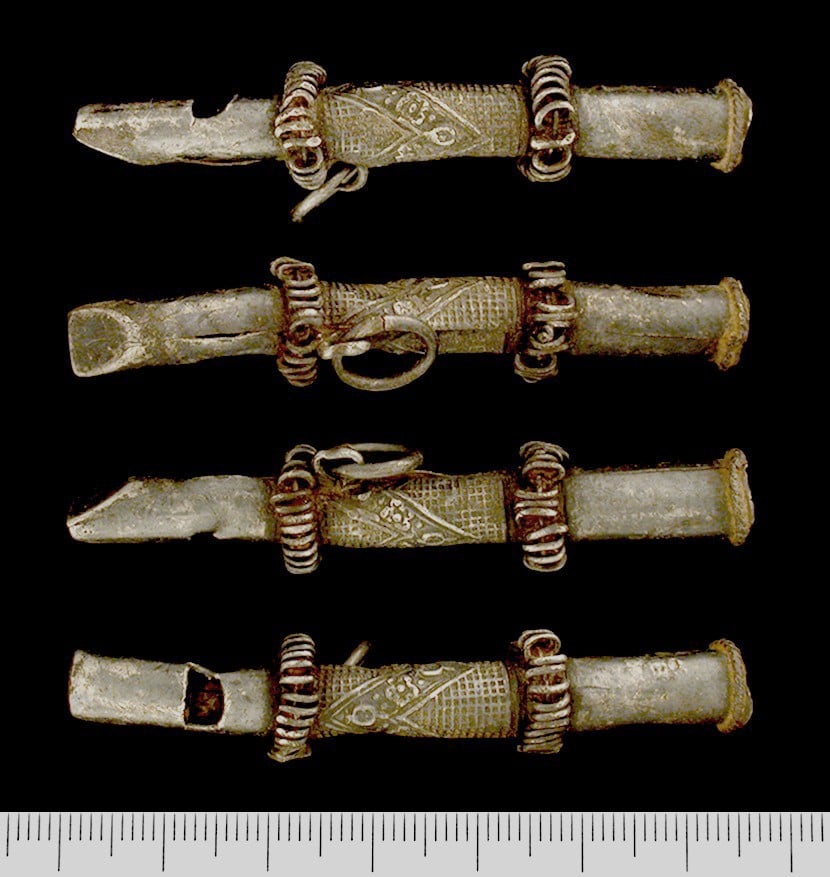The Treasure Act
Although the Portable Antiquities Scheme is voluntary, the Treasure Act 1996 states that finders must report individual objects (other than coins) which are more than 300 years old and which by weight are over 10% of gold or silver. Two or more of gold or silver coins, or ten or more base-metal coins found together and over 300 years old, also qualify as ‘Treasure’ under the Act, as do finds of two or more Prehistoric (Iron Age or earlier) base-metal objects found together. Objects found in association, for example, a ceramic pot which contains a coin hoard also qualify as Treasure.
The Treasure Act also states that a national or local museum may acquire items of Treasure for their collections. In this case the Coroner will hold an inquest to determine whether the item is Treasure. Later a current market valuation will be made by an independent committee of experts. Once the acquiring museum has paid for the find the payment is converted to an ex gratia reward and it is usually shared equally between the finder and landowner. The reward will be the full market value of the object.
If a museum does not wish to acquire a Treasure find it will be ‘disclaimed’ and handed back to the finder. However, the landowner and occupier (if different) will be informed of this decision and will have 28 days to give notice of any objection.
Further information about the Portable Antiquities Scheme and the Treasure Act can be obtained by contacting Frank Basford at:
County Archaeology and Historic Environment Service
61 Clatterford Road
Carisbrooke
NEWPORT
Isle of Wight
PO30 1NZ
Email: [email protected]
- 01983 823810
or The British Museum – Treasure Registrar
020 7323 8611
 |
Shalfleet Parish, Isle of Wight (2005 T96)
Date: Sixteenth century
Finder: Mr Keith Stuart
Date of discovery: 20/03/2005
Circumstances of discovery: Whilst searching with a metal-detector
Description: A silver huntsman’s whistle, cut from silver sheet, is folded and joined along the underside with a soldered seam. It increases in diameter from the mouth-piece to the open end. Two collars composed of spiralled silver wire divide the whistle into three sections. The first section has an obliquely angled mouth-piece and a D-shaped sound-hole. The second section is decorated with a grid of small punched squares. Upon this background are two chevron-shaped-panels which contain alternating motifs of roses and pomegranates. The third section has a stamped and very worn maker’s mark, a letter B within a shield. At the open end is a cabled band around the body. On the underside, is a small silver wire loop that secures a free running silver wire ring to facilitate attachment.
Discussion: A similar undecorated silver whistle has been recorded from the Chichester area of West Sussex. (Treasure Annual Report. 1998 -1999. 93, fig. 242).
Dimensions: Length 65.5mm. Weight 9.11g. The weight includes some soil within the whistle.
Metal content: The find contains a minimum of 10% silver.
Frank Basford, Finds Liaison Officer, Isle of Wight, March 2005
Date: Sixteenth century
Finder: Mr Keith Stuart
Date of discovery: 20/03/2005
Circumstances of discovery: Whilst searching with a metal-detector
Description: A silver huntsman’s whistle, cut from silver sheet, is folded and joined along the underside with a soldered seam. It increases in diameter from the mouth-piece to the open end. Two collars composed of spiralled silver wire divide the whistle into three sections. The first section has an obliquely angled mouth-piece and a D-shaped sound-hole. The second section is decorated with a grid of small punched squares. Upon this background are two chevron-shaped-panels which contain alternating motifs of roses and pomegranates. The third section has a stamped and very worn maker’s mark, a letter B within a shield. At the open end is a cabled band around the body. On the underside, is a small silver wire loop that secures a free running silver wire ring to facilitate attachment.
Discussion: A similar undecorated silver whistle has been recorded from the Chichester area of West Sussex. (Treasure Annual Report. 1998 -1999. 93, fig. 242).
Dimensions: Length 65.5mm. Weight 9.11g. The weight includes some soil within the whistle.
Metal content: The find contains a minimum of 10% silver.
Frank Basford, Finds Liaison Officer, Isle of Wight, March 2005
Page last updated on: 25/04/2006





